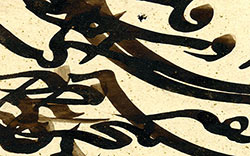Gholām Rezā Esfahani was born in Tehran in 1830 CE. He became interested in calligraphy at a very young age and as a young man was able to gain an audience with Mohammad Shāh Qājār to present his work. This initial meeting gained him access to the studio of Sayyed ‘Ali Hakkāk (the father of the calligrapher Mir Hosayn) where he worked until the year 1867 CE, a period during which he wrote the Nasta‘liq script in the style of the emulators of Mir ‘Emād. However, with his subsequent introduction to the Shakastah Nasta‘liq script, the stiltedness of Mir ‘Emād’s style gradually disappeared from his calligraphy. A unique style manifested in his works which demonstrates his mastery over the fluidity of the Shakastah form of the Nasta‘liq script. During these years he composed many works in a clear cursive style known as Shakastah-ay Jalli, which he signed with the name of another master, ‘Abd-al-Majid. He had mastery over composition in four different styles: Nasta‘liq, in the style of Mir ‘Emād; Shakastah, in the style of ‘Abd-al-Majid; improvised forms of Siyāh Mashq; Jalli (clear cursive) forms of Shakastah. It is rare to find such a combination of talent in a single artist, especially one who would go on to be known as the single most eminent practitioner of the Nasta‘liq script during the Qājār era, a period during which most poets and artists felt obligated to repeat and emulate the same standard styles.
During this time, Gholām Rezā was mostly supported by the Mo‘ayyer-al-Mamālek, a vizier of Nāser-al-Din Shāh (r. 1848-1896) though he himself had no direct contact with the king. For examples of his most masterful Jalli Nasta‘liq works, one should look to the inscriptions in the Sepahsalār Mosque in the south of Bahārestān Square in Tehran.
Gholām Rezā died in 1886 CE and is buried in the vicinity of modern-day Shahr-e-Rey near Cheshmeh ‘Ali.




